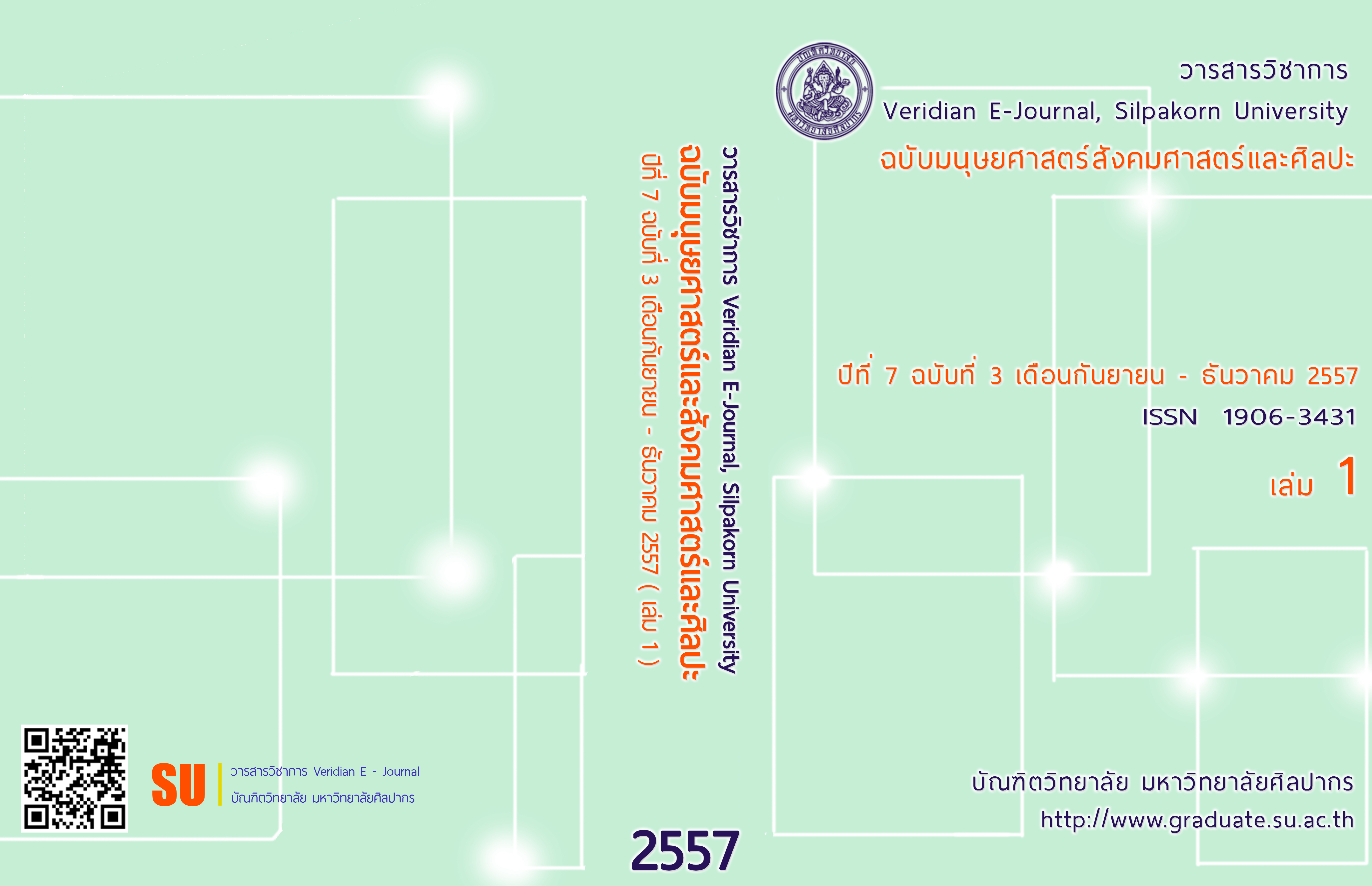ระบบการจัดการเอกสารราชการของสำนักราชเลขาธิการ
Main Article Content
บทคัดย่อ
บทคัดย่อ
การวิจัยนี้มีวัตถุประสงค์เพื่อศึกษาวิเคราะห์เอกสารราชการที่เกิดจากภารกิจ และศึกษาสภาพการจัดการเอกสารราชการของกองกลางและกองการในพระองค์ ในสังกัดสำนักราชเลขาธิการ การวิจัยนี้เป็นการวิจัยเชิงคุณภาพ ผู้ให้ข้อมูลประกอบด้วย ผู้อำนวยการกลุ่มงานอำนวยการและบริหารทั่วไป และตัวแทนบุคลากรผู้ปฏิบัติงานด้านการจัดการเอกสารของกองกลาง และกองการในพระองค์ รวมจำนวน 19 คน เครื่องมือที่ใช้ในการวิจัยคือ แบบบันทึกข้อมูลภารกิจและเอกสาร และแบบสัมภาษณ์ นำเสนอข้อมูลด้วยการวิเคราะห์เนื้อหาและการสรุปประเด็นสำคัญเชิงพรรณนา ประกอบภาพ และตาราง
สรุปผลการวิจัยได้ดังนี้ ลักษณะเอกสารที่ใช้ดำเนินงานของกองกลาง และกองการ ในพระองค์ แยกได้เป็น 3 ลักษณะ คือ 1. เอกสารตามภารกิจด้านการบริหารงานทั่วไป ซึ่งมีลักษณะคล้ายคลึงกัน 2. เอกสารเฉพาะ ตามภารกิจของกลุ่มงานในสังกัดกองกลาง และกองการในพระองค์ ซึ่งประกอบด้วย 2.1 เอกสารของงานแต่งตั้งและเข้าเฝ้าฯ และงานสถาปนาและเครื่องราชอิสริยาภรณ์ สังกัดกลุ่มงานอำนวยการและบริหาร ทั่วไป กองกลาง ได้แก่ พระบรมราชโองการ เอกสารสถาปนาสมณศักดิ์พระสงฆ์ ประกาศนียบัตรกำกับเครื่องราชอิสริยาภรณ์ และสัญญาบัตร 2.2 เอกสารเฉพาะของกลุ่มงานส่วนพระองค์ สังกัดกองการในพระองค์ คือ พระราชหัตถเลขาพระราชทานชื่อบุตรและบุตรี และพระราชหัตถเลขาพระราชทานชื่อสกุล และเอกสารเฉพาะของกลุ่มงานเสด็จพระราชดำเนิน กองการในพระองค์ คือ หมายกำหนดการพระราชพิธี ส่วนสภาพการจัดการเอกสาร ในด้านการบริหารงานมีการกำหนดแนวทางการปฏิบัติงานด้วยวาจา มีคู่มือการปฏิบัติงานสารบรรณอิเล็กทรอนิกส์ เรียกว่าโปรแกรมอินโฟมา และมีคู่มือการจัดเก็บเอกสารของสำนักราชเลขาธิการ ส่วนใหญ่ไม่มีการตั้งงบประมาณเฉพาะสำหรับงานสารบรรณ ไม่มีการกำหนดลักษณะเฉพาะของทรัพยากรที่ใช้จัดเก็บเอกสาร บุคลากรทุกคนเป็นผู้ปฏิบัติงานเอกสาร แต่มีขอบเขตความรับผิดชอบไม่เท่ากัน ไม่มีการจัดลำดับความสำคัญว่าเอกสารใดเป็นเอกสารที่สำคัญที่สุด ในด้านกระบวนการ ได้แก่ 1. การจัดทำเอกสาร แยกได้เป็น 3 ประเภท คือ เอกสารราชการทั่วไป เอกสารใบนำความกราบบังคมทูล และเอกสารการดำเนินงานเฉพาะด้านของแต่ละกอง มีขั้นตอนในการจัดทำคล้ายคลึงกัน ได้แก่ การร่าง การพิมพ์ การตรวจ การเสนอ และการทำสำเนา2. การรับ-ส่งเอกสารภายนอก ใช้การส่งทางไปรษณีย์เป็นหลัก เอกสารภายในจะส่งเอกสารต้นฉบับควบคู่กับการส่งและควบคุมด้วยโปรแกรมอินโฟมา รวมทั้งการจัดทำเอกสารหลักฐานการรับเอกสาร 3. การจัดเก็บเอกสารมีการแยกเก็บเอกสารที่อยู่ระหว่างปฏิบัติ เอกสารที่เก็บไว้ตรวจสอบ และเอกสารที่ปฏิบัติเสร็จแล้ว ซึ่งมีทั้งการจัดเก็บตามคู่มือ และการจัดเก็บตามความสะดวก ใช้การสืบค้นด้วยโปรแกรมอินโฟมาและระบบสนับสนุนเพิ่มเติม 4. การใช้เอกสาร มีการยืมใช้เอกสารโดยบุคคลภายในเพื่อใช้ดำเนินงาน ไม่มีหลักฐานการยืม 5. การกำจัดเอกสาร ไม่มีตารางกำหนดอายุเอกสาร แต่มีการย้ายเอกสารไปเก็บ ณ อาคารศูนย์สารสนเทศ สำนักราชเลขาธิการ และส่วนใหญ่ไม่มีการทำลายเอกสาร 6. การใช้เทคโนโลยีสารสนเทศในการดำเนินงานด้านเอกสาร มีระบบงาน 2 ลักษณะคือ ระบบงานร่วม และระบบงานสนับสนุนเฉพาะกอง 7. ปัญหาการจัดการเอกสารส่วนใหญ่คือขาดบุคลากร ขาดอุปกรณ์ที่มีคุณภาพดี และขาดพื้นที่ในการจัดเก็บเอกสารในสำนักงาน
Abstract
The purposes of this study were to 1) identify the records related to the functions of the General Affairs Division, and His Majesty’s Personal Affairs Division of the Office of His Majesty’s Principal Private Secretary (OHMPPS), and 2) study the records management systems of the two divisions of the OHMPPS.
The study was a qualitative research. The section heads of the two divisions, and 19 representative officers working on the records management were the research population. The instruments used for data gathering were in forms of institutional functional analysis and records, and schedule interviews about the OHMPPS’s records management systems. Summaries, descriptions, pictures, and tables were used for data analysis.
The results revealed as follows: 1) Records related to the functions of each section and division were the kinds of general management, and the records of specific mission included the royal command, ordination of the priest’s ranks, insignia certificate, the royal writing of naming and surname, and the program of royal ceremony. 2) There were the verbal approach of records management by conversation and unwritten policy. There were two manuals; e-recordkeeping system (INFOMA), and the OHMPPS’s records keeping. Generally, there was no budget setting up for record-keeping section, and the same materials were used for keeping the records. All officers work on records management in the different scopes. Awareness on the vital records was none. Three kinds of records were created in similar methods; general administration records, records of royal summaries, and the records of specific mission. Post was the main method for receipt and sending external records, both by hand and via e-recordkeeping system for internal records. Keeping records files were separated in three groups by individual officers; current records, semi-current records, and non-current records classified by their own methods or followed the manual of the OHMPPS’s recordkeeping. Searching the records, mostly used e-recordkeeping system, but there were other electronic support systems for each division. Lending records were handled by internal officers with no evident records. Inactive files were moved to the repository at the Royal Archives building in responsible of each division. There was no retention schedule, and weeding of records had never been done. Beside computers and general software for records creation and e-recordkeeping system, other electronic support systems of each division were used for keeping and searching e-records. The major problems in records management were lacking of personnel resources, good quality equipment, and enough spaces for keeping
